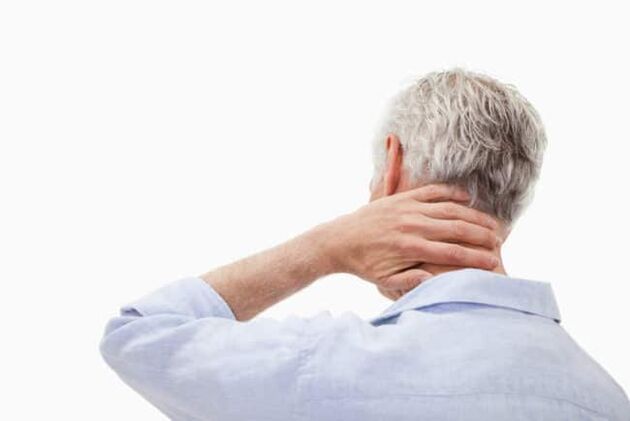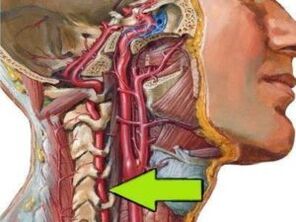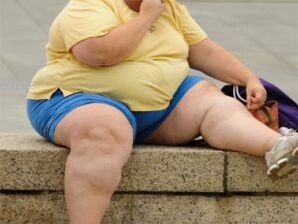All pathological processes that affect the spine in different parts include cervical osteochondrosis one of the most common and most painful ones.Many difficulties arise from this disease, mainly as it affects the spinal cord, and negatively affects brain functioning.

What is cervical osteochondrosis?
Cervical osteochondrosis words in medical practice means progressive disease that affects the specific spine.This pathological process is characterized by degradation-dystrophic processes in the tissues of intervertebrate discs, which are shock absorbers for the cervical vertebrates.It is due to the fact that they are destroyed and deformed.As a result, the distance between vertebrates is reduced and as a result the following consequences occur: \ t
- Narrowing the spinal canal in certain spine areas.
- Going over the vertebrate arteries - large blood vessels that provide blood supply to the brain.The supply of brain becomes worse and blood circulation is affected in the cervical spinal strings.
- Transitional discs can be discouraged and flattened.This means that individual parts of the spinal cord and nerves are squeezed, more often, the nervous roots are pressed.
Not only does all these problems violate the blood circulation of the brain, painful sensations in the neck, headache, etc ..According to the international classification of diseases, osteochondrosis assigned in the cervical region for some specific codes.The disease code for ICB 10 depends on the age of the disease: the disease was diagnosed:

- M02 - Delvation discs between -roots in adolescence.
- M42.12 is a dystrophic process in adult neck.
Many factors depend on the age of the patient and the extent of development of the pathological process, for example, consequences, difficulties, symptoms and, of course, the principles of treatment.
Causes
The reasons for the development of osteochondrosis of the cervical region in the diagnosis process, as well as determine the principles of combating disease, can play a decisive role.However, before you list the reasons, it is worth saying that doctors distinguish between two factors leading to the development of this pathological process:
- Pathological - destruction of discs between -invertebrate and other vertebrates with nearby tissue participation, blood vessels and nervous beams in the pathological process under the influence of external harmful factors.The more these factors and other pathologies, the fastest develops the disease.
- Physiological - based on the development of pathology, mostly age -related changes.We are talking about the natural aging of cartilaginous tissues in the spinal column, salt, etc ..
If we list more specific reasons for cervical osteochondrosis, they are as follows:
- Infringement of metabolic processes in the body, as well as certain degrees of obesity.
- Hypodynamia is a phenomenon characterized by mobility limitation.Not only does it apply to injuries or diseases, this can also include a sedentary lifestyle and sitting work.
- Pathologies of the cardiovascular system, contributing to impaired blood circulation in the brain, pressure changes and other objects.
- Incorrect posture, these are different forms of scoliosis, rheumatic and even flat legs.
- Injection of the cervical spinal.In this case, we are talking about sprains, strikes, bruises.Investigations of another spine in the development of cervical osteochondrosis can influence the development of cervical osteochondrosis.
- The cervical region is too much physical due to intense or heavy heavy physical, depending on the type of human activity.
- A sedentary lifestyle is also dangerous with persistent tension on the cervical spine and the whole spine, if you sit incorrectly or on uncomfortable furniture.
- A hernia of the cervical spine, as well as various related diseases.
- Oblige the long -term holding of the head in an uncomfortable or unnatural position.In this case, not only does muscular satisfied, but the spine is also curved in the cervical region.
- The doctors consider that the doctors are a very common cause and are too common.
- One of the causes of congenital anomalies is also considered in the spinal structure.

What is the risk of health?
As mentioned earlier, in the cervical spine, not only is the spinal cord and various nervous branches located, but also the spinal arteries that provide the occipital part of the brain, the cerebellum and the medieval brain.With the development of cervical osteochondrosis, nearby tissues are inflamed.In addition, there is a threat to the development of pathology to squeeze the nervous roots and transmit blood vessels, the following are the consequences:
- Together with osteochondrosis is spinal deformation, resulting in the cerebrospinal canal in certain areas.This can lead to the result of the spinal cord and nervous branches, giving a commitment to serious neurological problems.In severe cases, a person feels pain, even there is a possibility of losing control of individual parts of the body (mainly in the hand or face).
- A violation of blood circulation in the occipital region of the brain is accompanied by the neck vessels, as already mentioned.At the same time, the brain of oxygen and nutrients will cease to be found in the essential amounts, oxygen hunger begins.With circulatory disorders, there is a real risk of various ischemic stroke and neurological pathologies.
Syndromes
The main synthesis are:
- Vertebrate.
- Vertebrate artery.
- Koreshka.
- Cardiac.
It is important to know that all of these symptoms have painful emotions of a different nature, as well as many unfavorable clinical symptoms.One can feel dizziness, noise is seen in his ears and much more.

Vertebrate syndrome
It talks about a direct osteochondrosis connection of the cervical region with bone and cartilaginous tissues.Signs in this type of pathology are also associated with lesions of tissues mentioned:
- The movements of the neck are partially or completely limited.
- The movements of the head have pain in the neck.
- X -Ray shows morphological changes in the tissues (between -artebrate and in the body of vertebrates).
It is worth noting that these three clinical signs are always accompanied by the vertebrate syndrome.If at least 1 are absent, the diagnosis will be completely different.
ROOK syndrome
It occurs when spinal cord roots are damaged.At the same time, nervous conductivity is affected, one can detect pain or lose the sensitivity of individual parts of the body or even tolerate paralysis.Depending on which of the 8 radical couples there is disturbance of conductivity, these symptoms are distinguished:
- 1 pair - numbness or pain in the back of the head;
- 3 pair - violation of chewing recurring, numbness of the language and the unpleasant sensations behind the ears;
- 4 pair - pain in the chlavicle, violation of the swallowing recurring;
- 5 pair - violations of the shoulder additive, combined with the problem of manual movement;
- 6 pair - the patient begins to feel pain and numbness in the forearm and shoulder blades;
- 7 pair - hands and fingers go numb (often index and middle);
- 8 pair - problems are similar to the previous item, but numbness is detected in the ring finger and in the small finger.
Friendly syndrome
Despite the fact that the pathological process is still localized in the cervical spine, the syndrome has all signs of heart pathologies.The clinical picture is as follows:
- Pulse fast.
- Pain in the region of the sternum.
- Breath clip, weakness, inertia, reduction of performance.
Signs and symptoms of cervical osteochondrosis
To seek a doctor in a timely manner, it is necessary to understand cervical osteochondrosis signs clearly.In some cases, this information allows you to seek help at the early stages of the disease, when it is easier to treat it.In general, the symptoms for osteochondrosis of the cervical spinal are as follows:

- Pain for osteochondrosis is always present, there is only a different intensity and frequency.The pain is the first clinical sign.Their intensity depends on the progress of the disease, as nature they are stupid or pushing.Painful sensations are mostly present in the neck of the occipital region, but they can radiate with the time region, shoulder girdle and hands.
- In most cases, there is an indication of lesions of the vestibular apparatus.We are talking about dizziness without reasons, wheed, impaired coordination movements, uneven gait, loss in space.
- One of the most common clinical symptoms is the intensity of neck muscle and stiffness of movements.It is difficult for a person to spin, lower and wear his head, moves with pain pieces.
- Many patients notice the feeling that goosebumps are “running through the scalp” or that tingling feels characteristic.
- In the area of hands there is a weakness and muscular numbness.
- There are often psychological demonstrations, expressed in depression, drowiness, in a sharp change of mood, the temper or irritability.
- Due to the impaired blood circulation and the damage to the brain tissue, dizziness goes more intense and it seems that the noise in the ears, such as attraction, pulsation, ring.
- Most patients cause visual impairment, as well as pain in eye walls, especially when trying to cut the eyes heavily left, right, up or down.
Sometimes the amount of development of the pathological process can be determined by signs.However, to make a full diagnosis of this, this is not yet sufficient and some diagnostic measures are required.
Diagnostic methods
The diagnosis of osteochondrosis of the cervical spinal is required to determine the localization and progress of the disease.For full diagnosis, such diagnostic methods are required:
- X -Ray -the main mode that allows you to determine the stage and localization of the deformation of the spinal column.
- You can use calculated tomography to make a more accurate diagnosis of pathological changes in vertebrates and intervertebral discs.
- MRI (Magnetresonance imaging) - it leaves the wheels and vertebrates can be examined in detail, the presence of hernias, extrusions, and the scale of lesions to determine the rest.
- Doplography - at the same time, the examination is the opportunity to find a place to squeeze the artery, assess the amount of circulatory disorders.
Treatment methods
Treatment of neck osteochondrosis always implies an integrated approach.The principles of treatment depend on the mass of factors, such as the age of the patient, the development of the disease, the brightness of the clinical paintings, etc.For the integrated approach: osteochondrosis treats the cervical osteochondrosis using drug therapy, physiotherapy, massages, fitness therapy and other methods that should be discussed in more detail.
Drug treatment
The basis for the treatment of cervical osteochondrosis is drug therapy, related to tablets, drugs and drugs of these groups:
- Anesthetics - analgesics and antispasmodics.The nervous -venue was just going, which stopped painful emotions.The latter allows you to relieve the neck muscle spasm, establish blood flow and prevent pain.
- NSAIDs -the anti -reflective drugs need to reduce the inflammatory process, most of them end pain.These drugs are often used in the form of gels, ointments inserted into the area concerned.
- Musorelaxants are another way to remove muscle spasm in the cervical region.
- Chondroprotectors are mandatory at certain stages of chop osteochondrosis, because they contribute to bone tissue reform.
- B vitamins - normalize the metabolic processes of nervous tissue, improve the conductivity of nervous -impulses and contribute to the work of the central nervous system.
Remember, treatment should only be done under the supervision of a doctor, which is responsible for appointing all medicines, as well as the length of its intake and determining its dose.
Physiotherapy
Treatment of neck osteochondrosis will be much more effective using some physiotherapy techniques:

- Electrophoresis.
- Laser therapy.
- Ultrasound.
- Massage.
Experienced health worker needs to make massage therapy, treatment is carried out at least 10 sessions.Massages of the cervical region help to normalize blood circulation, restore elasticity, relieve muscle tone, etc ..
Manual therapy
Manual therapy is based on the principle of restoring motor functions and mobility between vertebrates.Initially, the manuals are in a relaxed mild massage, then the doctor puts more and more strength, it acts on pressure vertebrates and turns the neck.
The use of Kuznetsov applicants is one of the methods of therapy for spinal diseases, including osteochondrosis.The adaptation effect of the cervical region normalizes metabolic processes, reduces pain, increases muscle tone, improves blood circulation, increases the conductivity of nervous tissue, etc ..To prevent osteochondrosis, it is useful to engage in swimming and hung on the horizontal bar for 2-3 minutes every day.


























































































